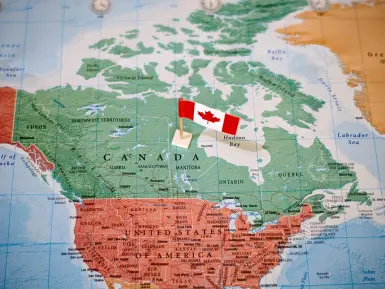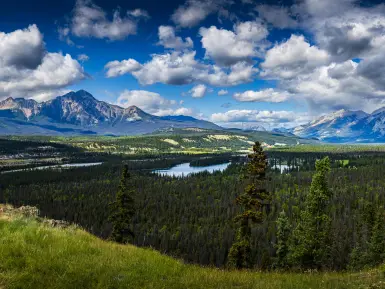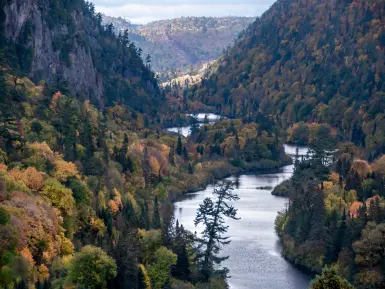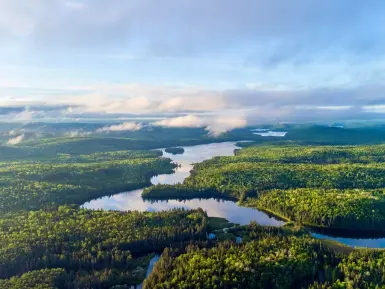There’s no question that the Canadian Rockies are one of the most beautiful destinations anywhere in the world, replete with breath-taking scenery and majestic wildlife. In fact, discovering the many animals that populate the Rockies is one of the main draws for those visiting the area. You’ll be able to spot wildlife whether you travel by car or choose to travel on the famous train called Rocky Mountaineer. For those who aren’t blessed to live within a stone’s throw of iconic animals, the variety of furry residents will seem truly staggering. If wildlife watching is something that you would like to do on your next holiday, then this guide to discovering the wildlife of the Canadian Rockies will be for you. Here we will delve into when, where, and what to see in this beautiful corner of Canada.
When to see wildlife in the Canadian Rockies
So, you’re heading to the Canadian Rockies but when is the best time to see the incredible wildlife that lives there? Well, while there are no guarantees, there are times of the day and year that you can maximise your chances. Early morning is always a good shout, getting up and out around dawn will provide for some excellent opportunities to spot animals like elk and bears. Late afternoon is also a time that wildlife-watchers will target, as well as just before the sun goes down, as these are times where a lot of the animals will be feeding, causing them to be out and about where you might catch a glimpse!

How about the time of year? Of course, animals live in the Rockies all year round, but between weather and hibernation, there are certain seasons when the wildlife is easier to spot. Spring, autumn, and winter are often the best times of the year for this. Grazing animals like elk, deer and bighorn sheep can be found moving to lower elevations and near to towns for food in winter – making them easier to find as a result. Bears are certainly one animal that can be seen often in autumn, as this is when they are foraging in earnest so that they can put on enough weight before winter hibernation. If you are an avid bird watcher, however, spring and summer are optimal seasons. Spring is also a great time to spot animals with their young and emerging from hibernation.
The above advice is definitely reflected in the experience of Maya from the travel and adventure blog, Travel with the Smile, who told us that her favourite animals to watch are bears, in locations close to mountains and forests, or when visiting national parks: “I love to watch them, especially in spring when mama bears have little cubs. I had the best luck observing wildlife early in the morning or later in the evening.”
Canadian Rockies’ animals and where to find them

There are myriad marvels of the animal kingdom populating the Canadian Rockies - so many that we couldn’t possibly include them all here. But to give you a taste of what to expect, we’ve selected a few iconic animals below, letting you know the places best suited to seeing wildlife for yourself.
Before we get into it, we wanted to bring you a few words from Kerri Martin, a Canadian wildlife photographer who is very familiar with the Rockies. We asked Kerri about her favourite spots for discovering wildlife: “I have a hard time answering the question because I don't have a favourite - I love all of Alberta. There are the typical tourist destinations of Banff and Jasper but there is a lot more. And there is a lot more than the big game like bears, elk, moose, etc. I would encourage international visitors to look beyond some of the iconic species of Canada and really enjoy the biodiversity of the area, including the bird life, plant life and even the smaller animals that do not get a lot of press.”
Gemma, from the adventure-travel blog Off Track Travel, has also spent time discovering wildlife in the Canadian Rockies, and she spoke to us about her favourite animal-encounters: “While travelling the Canadian Rockies over the last few years we have, so far, been lucky enough to see both grizzly and black bears, lynx, bighorn sheep, mountain goats and deer. Quite a variety, I'm sure you can agree! Outside the backcountry, the areas where we've had the most luck for wildlife watching in the Rockies have to be the Banff Parkway (running parallel to Highway 1) and Highway 93 near Radium Hot Springs. The latter is a 'no stop' zone at certain times of the year due to the amount of grizzly bear activity in the area.”
Before telling us about her favourite animal in the area (which you can read about further on in this guide) Marta Kulesza, a travel blogger and photographer from the website In a Far Away Land, spoke to us about her favourite locations for spotting wildlife in the Canadian Rockies: “My favourite area in the Canadian Rockies for wildlife spotting is Kananaskis country. I have seen several grizzly sows with their cubs eating berries on the side of the road and numerous mountain goats and bighorn sheep defying gravity and grazing in the most obscure predator-free areas around the peaks. A breath-taking sight if ever there was one.”
Grizzly Bears

Image credit: Waking Up Wild
When thinking of Canadian wildlife, many a mind will turn to the grizzly bear. These magnificent creatures are certainly iconic and spotting one will surely be a highlight of any trip. Megan, from the travel blog, Mapping Megan, has had a great time exploring the Canadian Rockies herself, discovering the wildlife that exists there. Megan told us that seeing the bears was a true highlight of her trip:
“Definitely grizzly bears... from a distance of course! Bears are curious, intelligent and majestic animals, and every year millions of travellers have the opportunity to safely observe them without any confrontation. They are potentially dangerous, though conflicts with wildlife are primarily due to inappropriate human behaviour anyway, and people are usually only injured if they get too close or are in the animal’s way.
“It is so important to be ‘bear aware’ when camping and hiking through the Canadian Rockies – staying calm and having knowledge of the proper behaviour will increase the odds of a positive outcome for both you and the bear.”
Where in the Canadian Rockies might one get to see some of these stunning animals? Megan offered us her advice: “If you're looking to maximize your chances of seeing one, your best bet would be around the Lake Louise Gondola. Keep your eyes peeled as you can spot them on any road throughout the region, like the Bow Valley Parkway, Lake Moraine Road, or the Lake Minnewanka Scenic Drive. The best tip for any type of wildlife viewing is to be out around dawn and/or dusk, as this is when wildlife will be most active.”
Black bears

Image credit: Kerri Martin Photography (taken via zoom lens)
Even more common than grizzlies in the Canadian Rockies are black bears, with locations across the wilderness providing opportunities for sightings. Rhonda Krause, a writer and photographer from the travel blog Travel? Yes Please!, named these wonderful animals as a highlight of her trip to the area: “My most memorable wildlife sighting in Jasper was seeing a black bear and two cubs grazing near the shore of Medicine Lake. I had never seen bear cubs in the wild before, so it was wonderful to sit and watch them in their natural habitat."
Rhonda also shared with us a little bit of advice for wildlife watching when in this corner of the world: “For those looking to view wildlife in the Canadian Rockies, I’d recommend a trip to Jasper National Park. I never fail to see wildlife there, whether it’s bighorn sheep walking alongside Highway 16, or elk roaming the fields near the Jasper townsite, wildlife sightings are common in every season.”
Wolves

Image credit: Kerri Martin Photography (taken via zoom lens)
Another animal that populates the Canadian Rockies are wolves, and although they are very elusive by nature, many a visitor would certainly love to spot one (from a safe distance, of course!). Jasper is a spot where these striking animals can be found but it’s no guarantee so don’t be disappointed if you don’t come across one. For a safe compromise that will guarantee results, spots like Yamnuska Wolfdog Sanctuary near Banff offer visitors an opportunity to meet wolfdogs. The sanctuary promotes responsible wolfdog ownership while also the preservation of wolves in the wild.
An organisation that is dedicated to raising awareness about the issues facing wolves in the Canadian Rockies/Alberta is Wolf Matters. The team kindly spoke to us about their work and the status of wolves in the area: “Wolves are mostly confined to the Rocky Mountains, foothills regions and boreal forests in Western Canada. The government of Alberta lists the gray wolf as not rare or endangered, however, they do not provide a population status on their website. According to other sources, however, present-day wolf numbers are estimated to number around 4,000-5,000 in Alberta. This number, of course, varies from province/territory. It is important to note that current wolf statistics are hard to validate as it is exceptionally difficult to determine the number of wolves that populate any given location (any official government numbers are always estimates).
“Wolf Matters is an organization that is advocating for improved and more responsible management and treatment of wolves in Alberta and building awareness about the environmental impacts associated with the indiscriminate killing of a much-needed and valued keystone species. We provide public education about the importance of wild canids on the Alberta landscape and how to peacefully co-exist with them. We host events at numerous venues, and we have a great education program that can be tailored to any age group.”

Wolf Awareness Inc. is a non-profit charitable foundation, which promotes positive attitudes towards wolves and works with research projects across Canada. The team at Wolf Awareness Inc. spoke to us about the lives of wolves in the Canadian Rockies: “Wolves in the Canadian Rockies live at lower densities than wolves in other habitats largely due to their main food source, ungulates (hoofed mammals like elk, moose and deer) being limited to valley bottoms, which are also the same areas used and occupied by humans. Territory requirements can be up to 3,000 square kilometres for a single wolf family in the Central Rocky Mountains. On top of this, most areas of Canada do not offer protection for wolves, allowing them to be hunted or trapped for large segments of the year, often without limits.
Wolf Awareness Inc. also offered visitors advice regarding encounters with these precious animals in the wild: “Encounters with wolves are rare, as they are shy by nature. In wilderness areas, respect for wildlife requires that if dogs are permitted, they are kept on a leash at all times and that areas known as wolf den sites are left alone. Due to lax hunting and trapping regulations outside of National Parks and bounties on wolves and coyotes in some areas where they overlap with livestock or caribou in Alberta, it is best to keep wolves wary of humans.
“Do not approach wolves, and do not encourage wildlife to approach you. Never allow wolves or other wildlife to access human foods, either by feeding them or through irresponsible management at a picnic or camping site. Human mistakes have, can, and do lead to the unnecessary death of wolves all too often. Understanding and working with the natural behaviour of carnivores to prevent habituation will keep them wild.”
Pika

Image credit: Marta Kulesza (In a Faraway Land)
Some of the most fascinating animals that exist in the Canadian Rockies also happen to be the smallest. The pika, a little rabbit-like creature with short ears, is certainly one of these. Marta Kulesza from In a Far Away Land, highlights the pika as a true favourite of the area:
“I remember watching the first series of Planet Earth with David Attenborough. He shed light on a little animal living amongst the harsh environment of the Canadian Rockies - the pika. You can often hear them on hikes but because of their tiny size, fast movement and great camouflage skills, they blend effortlessly with the rocks and seeing one is often troublesome. This episode taught me how smart pikas are. They don’t hibernate. Instead, they spend their summers gathering enough food to get them through the winter but some plants they collect are poisonous. However, they dry them and stack them in such an order that by the time the plant is eaten it has lost its potentially deadly potency. Ever since then, whenever I went on hikes, I made it my mission to capture a photograph of a pika.”
Beavers

Beavers are certainly a common sighting in the Canadian Rockies. These fuzzy little guys can be found swimming in rivers (and building dams, of course) and in wetlands located near major towns that populate the area. Beavers are often spotted around Vermillion Lakes in Banff, and the Fenland Trail is a good bet too. Those familiar with beavers will know that they are nocturnal so if you want to spot one during your trip, keep an eye out during sunset as this is when they will come out from their slumber.
Moose

Canada and moose go hand in hand for many, and in the Canadian Rockies, these impressive creatures can be found among the lush wilderness, minding their own business. Moose are very shy, so you won’t find them eagerly rushing to greet you, but these lovely animals can at times be spotted down at Moose Meadows in Banff. Moose also tend to hang out near the road as they are rather fond of licking the salt off the cars. Jasper will also be a good bet, particularly at the aptly named Moose Lake Loop.
Elk

One of the most commonly seen animals in the Canadian Rockies is the elk, a creature both distinctive and hard to miss. Elk can be found in locations across the Rockies, with your chance of spotting them increased even further during rutting season in September. Jasper National Park is a recommended location if you want to narrow it down, a place where the elk can be found grazing on the grass. Banff and Canmore are also locations to take note of. Visitors must remember, however, that elk can be very aggressive, especially males in rutting season, so make sure to keep your distance and behave appropriately.
Grey Jay

For you bird-watchers out there, the grey jay is one that you will certainly want to get a sight of. Also known as the Canada jay, these birds are often thought of as Canada’s unofficial national bird. Banff will provide many opportunities to see the jay and, luckily, it sticks around all year, which is certainly kind of them! Grey jays are smart, stocking up food in autumn by sticking it to trees with their saliva to retrieve in winter! Keep your eyes open and be on the lookout for this lovely little bird.
Conservation in the Canadian Rockies

Image credit: Marta Kulesza (In a Faraway Land)
Wildlife Habitat Canada, an organisation which supports habitat conservation projects across Canada, knows a thing or two about wildlife in the Canadian Rockies. The team at WHC spoke to us a little about the great work they help make possible: “In 1985, Wildlife Habitat Canada (WHC) and the federal government founded a national Grant Program, which has now invested more than $55 million in support of more than 1,500 conservation and stewardship projects across Canada. Every year, WHC receives many grant applications from project proponents doing work in British Columbia – including those in and around the Canadian Rockies.
“Through the Grant Program and Stamp Initiative, WHC works with communities, landowners, governments, NGOs, and industry to conserve, enhance, and restore wildlife habitat on working lands. Through on-the-ground conservation, research and education, grant projects benefit wetland and upland habitats, waterfowl, species at risk, invasive species, biodiversity conservation, and aquatic and fish ecosystems.”
Cameron Mack, executive director of Wildlife Habitat Canada, also spoke to us about what he believes makes the Canadian Rockies a place of such diverse and majestic wildlife: “The Canadian Rockies are an immense and iconic landform, but many Canadians don’t realize how sensitive its ecosystems are. Residential and industrial development, climate change, invasive species and other impacts have threatened and destroyed habitats and the wildlife that depend on them. Fortunately, many communities and individuals have dedicated their time and resources to protect and restore these habitats through stewardship activities, for future generations to enjoy.”
Wildlife and animals of the Canadian Rockies

We hope you have enjoyed this introductory look into Canadian Rockies wildlife. As you can see, the animals and creatures living here are diverse and abundant, and completely different to what you’re used to seeing back home! When wildlife-watching, however, we must remember that these are wild animals, some of which can be very dangerous. Keep your distance, obey the rules of guides and advice from locals, and treat these animals with the respect they deserve. Of course, the above-featured creatures are but a taste of what to expect. Below we have included a fly-by list of a few more animals that call the magnificent Canadian Rockies home:
- Grizzly bears
- Wolves
- Moose
- Beavers
- Elk
- Grey jay
- Black bears
- Mountain goats
- Bighorn sheep
- Deer
- Porcupines
- Chipmunks
- Marmots
- Grouse
- Osprey
- Cougars
To arrange your trip to the Canadian Rockies, make sure to explore our packages available, including the Canadian Rockies by Rail Holiday.
Latest Articles

How big is Canada?


03/07/2025
A question that many people ask is ‘how big is Canada’? Most people know Canada is big, but just how big is big?

Canada Advocate Q&A: Trish & Cathie's Race Across The World Adventure


01/07/2025
Join us this Canada Day as we celebrate the breathtaking beauty of Canada with Trish & Cathie, the incredible winners of Race Across the World series 3! Discover Canada through the inspiring lens of two adventurers who truly fell in love with its majestic landscapes and vibrant culture.

Sault Ste. Marie Travel Guide: Undiscovered Canada


30/06/2025
Sault Ste. Marie in Canada is one of Ontario’s premier adventure towns, known for its rugged lakes, mountains, and world-class outdoor activities.

Algonquin Park Travel Guide: Iconic Canada


25/06/2025
Algonquin Provincial Park is one of Canada’s most spectacular wilderness regions. The park, which is Ontario’s oldest and largest provincial park, is filled with rocky ridges, fragrant maples and thousands of lakes.











